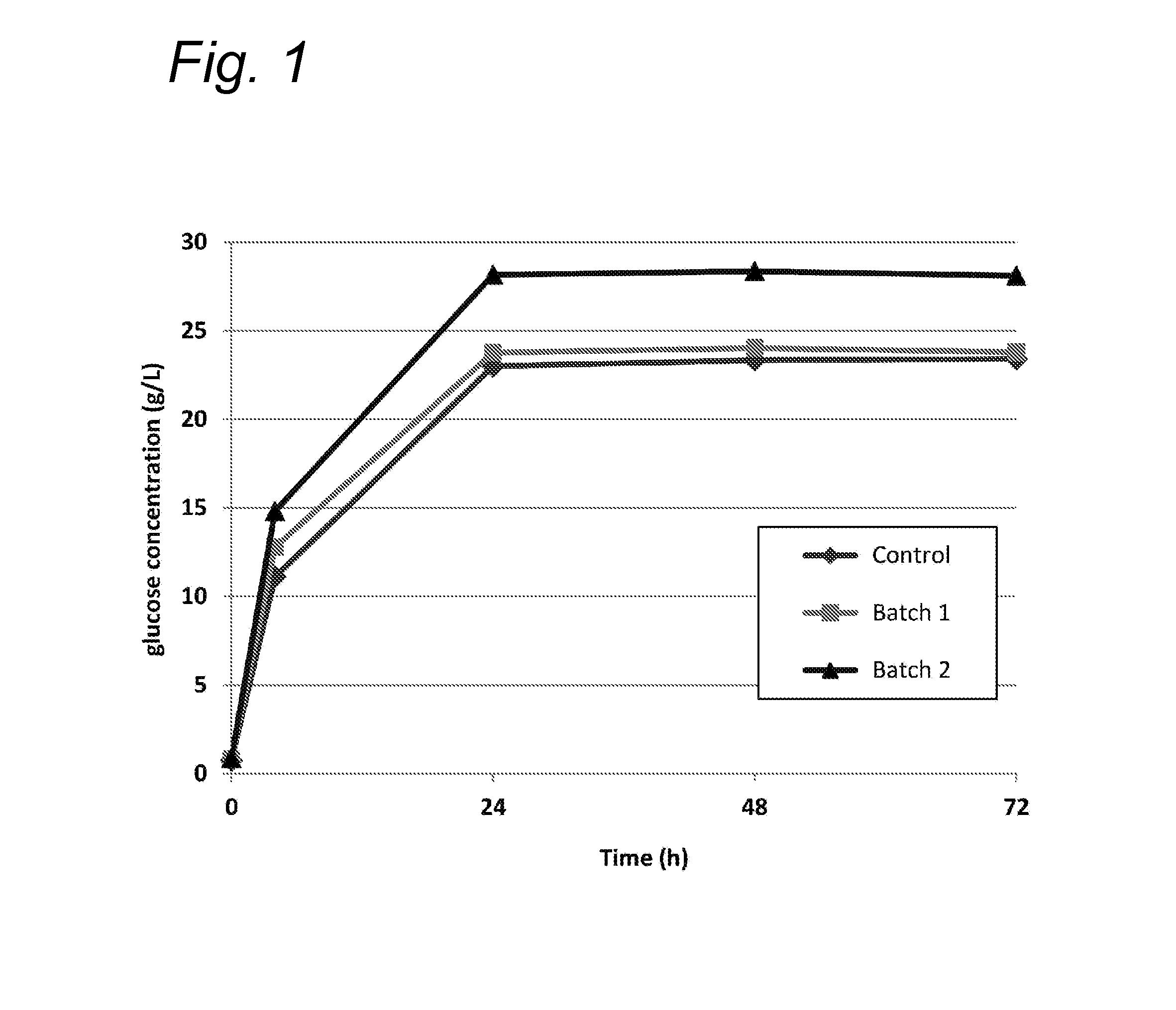Process for the treatment of lignocellulosic biomass
a technology of lignocellulosic biomass and lignocellulosic biomass, which is applied in the direction of lignin derivatives, glucose production, biofuels, etc., can solve the problems of hemicellulose derived from hemicellulose, hemicellulose present in lignocellulosic biomass is relatively unstable and broken down, and the performance of the organosolv step itself is improved, and the effect of efficient enzymatic hydrolysis of cellulos
- Summary
- Abstract
- Description
- Claims
- Application Information
AI Technical Summary
Benefits of technology
Problems solved by technology
Method used
Image
Examples
example 1
(Pre-)Extraction+Low Temperature Organosolv+Enzymatic Hydrolysis
[0068]A first batch (batch 1) of wheat straw was pre-extracted using 10 L water per kg biomass. A second batch (batch 2) of wheat straw was first pre-extracted using the same conditions as for the first batch, and subsequently extracted with 10 L ethanol (containing about 4 wt % water) per kg biomass. Both pre-extraction and extraction were performed using a Soxhlet extractor. Both batches 1 and 2 of wheat straw were subjected to organosolv, as well as a batch of wheat straw, which has not undergone (pre-)extraction (control). Organosolv conditions employed: 140° C.; 120 min; solvent=ethanol / water (60 / 40 w / w); liquid / solid ratio=10 L / kg; 50 mM H2SO4 for the (pre-)extracted wheat straw; 60 mM H2SO4 for the control experiment. The increased H2SO4 concentration for the control experiment is to counteract the higher acid-neutralisation capacity of the mineral part of the original biomass, which is lowered during pre-extract...
example 2
(Pre-)Extraction+Organosolv
[0073]Two batches (batches 1 and 3) of wheat straw (2SO4 for the (pre-)extracted batch 1; 120 mM H2SO4 for the control batch 2. Organosolv conditions employed for batches 3 and 4: high temperature organosolv at 190° C.; 60 min; solvent=ethanol / water (60 / 40 w / w); liquid / solid ratio=5 L / kg; 30 mM H2SO4 for the (pre-)extracted batch 3; 60 mM H2SO4 for the control batch 2. The increased H2SO4 concentration for the control experiment is to counteract the higher acid-neutralisation capacity of the mineral part of the original biomass, which is lowered during pre-extraction by (partial) removal of the mineral part. In order to ensure proper wetting of the biomass when using a liquid-solid ratio of 5 L / kg, the wheat straw was placed in a porous metal basket and compressed with a mechanical press. The basket was placed in the autoclave below the level of the liquor. The liquid-solid ratio of 5 L / kg refers to the overall ratio in the autoclave.
[0074]The negative eff...
example 3
(Pre-)Extraction+Low Temperature Organosolv+Enzymatic Hydrolysis
[0077]Wheat straw was chopped into pieces of about 1 cm length, and was divided into eight batches which received different treatments as summarised in Table 6. Pre-extraction was performed on batches 2, 5 and 7, which involved extraction with 10 L water per kg biomass, and subsequently with 10 L ethanol or acetone per kg of the original biomass prior to aqueous extraction. Both pre-extraction and extraction of batches 1 and 3 were performed in a counter-current stage-wise mode. Batches 1-8 were subsequently subjected to organosolv at the indicated temperature, using the solvent system and treatment time as given in Table 6. The liquid / solid ratio was 10 L per kg biomass. Sulfuric acid was added to the treatment liquid of batches 1-7. The increased H2SO4 concentration for the batches which did not undergo pre-extraction (1, 3, 4, 6) was applied to counteract the higher acid-neutralisation capacity of the mineral part of...
PUM
| Property | Measurement | Unit |
|---|---|---|
| temperature | aaaaa | aaaaa |
| temperature | aaaaa | aaaaa |
| temperature | aaaaa | aaaaa |
Abstract
Description
Claims
Application Information
 Login to View More
Login to View More - R&D
- Intellectual Property
- Life Sciences
- Materials
- Tech Scout
- Unparalleled Data Quality
- Higher Quality Content
- 60% Fewer Hallucinations
Browse by: Latest US Patents, China's latest patents, Technical Efficacy Thesaurus, Application Domain, Technology Topic, Popular Technical Reports.
© 2025 PatSnap. All rights reserved.Legal|Privacy policy|Modern Slavery Act Transparency Statement|Sitemap|About US| Contact US: help@patsnap.com


